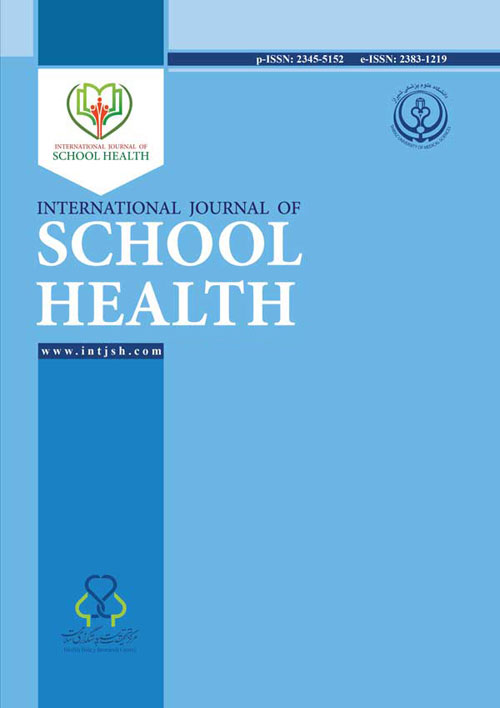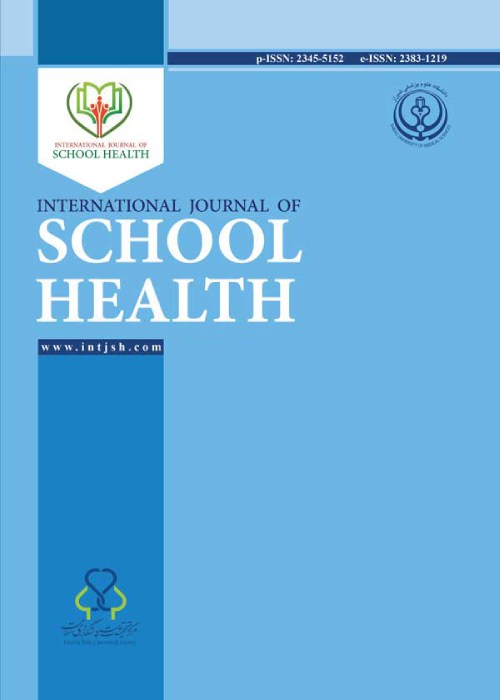فهرست مطالب

International Journal of School Health
Volume:9 Issue: 1, Winter 2022
- تاریخ انتشار: 1400/12/22
- تعداد عناوین: 8
-
-
Pages 1-9Background
Finding behavioral changes in youth during the COVID-19 pandemic may provide a better image of the negative impact of quarantine on their mental and physical health. The purpose of the present research was to examine the smartphone usage status, sleep pattern, health-related quality of life, and physical activity among adolescents from before to during the COVID-19 confinement.
MethodsThe present study used a descriptive-comparative design. The participants were 384 male and female students aged 16 to 18 years (mean age of 16.84±1.06 years) in grades 11 and 12 from the high-schools of Golestan province, Iran, in 2020. Screen time, sleep pattern, health-related quality of life, and physical activity were measured using standard questionnaires. Paired-Sample t test was employed to compare the means of the constructs of the study from “before” to “during” the COVID-19 pandemic. Independent t test was used to measure gender differences.
ResultsResults shed light on the increments in smartphone use and decrements in sleep quality, health-related quality of life, and physical activity among adolescents from “before” to “during” the COVID-19 pandemic (all p <0.001). Girls had significantly higher use of smartphones in both “before” (P=0.003) and “during” (p <0.001) the pandemic compared with boys. However, no other gender differences were found among male and female adolescents (all P>0.05).
ConclusionThe findings of this study revealed the effects of policies related to COVID-19 pandemic on health-related behaviors among adolescents and emphasized the importance of adopting appropriate coping strategies to promote healthy lifestyle during confinement.
Keywords: COVID-19, Physical Activity, Sleep, Quality of life, Adolescents -
Pages 11-17Background
The tendency to the use of drugs is a daily increase, especially among adolescents. We conducted the present study to investigate the role of self-efficacy in predicting drug-seeking behaviors among high school students in Jahrom, Fars province, Iran.
MethodsThis cross-sectional study was performed on high school students in Jahrom, Fars province, Iran in 2020. The sample size was estimated to be 405 people who were chosen using multi-stage cluster sampling. The data collection tools here included demographic information questionnaire, Iranian Addiction Potential Scale, and self-efficacy questionnaire Children Scale. Data analysis was performed with SPSS version 21 using descriptive statistics and Pearson’s correlation coefficient, Independent t-test, One-way ANOVA, and Linear regression.
ResultsThere was a significant inverse correlation between self-efficacy and drug-seeking behaviors (r=-598, p <0.001). Additionally, the results revealed a relationship between grade, father’s job, mother’s education, and smoking history in friends and parents with self-efficacy (P=0.002, P=0.012, P=0.004, P=0.006, P=0.005, respectively) and drug-seeking behaviors (p <0.001). Father’s job, friends’ smoking history, and self-efficacy were significant factors inversely associated with drug-seeking behaviors (P=0.003, p <0.001, p <0.001, respectively).
ConclusionHigh levels of self-efficacy of students and educated families can play a protective role against drugs use. Further focus on prevention, especially on capacity building and the empowerment of young people can reduce the tendency to use drugs.
Keywords: Students, Self-efficacy, Drug-seeking behavior, Adolescent -
Pages 18-25Background
Attention-deficit/hyperactivity disorder (ADHD) is a serious behavioral disorder with considerable personal and social consequences, including significant emotional distress among elementary school students and their caregivers. The present study aimed to investigate the effectiveness of parent-child interaction therapy (PCIT) and mindfulness-based therapy (MBT) on the behavioral problems of students with ADHD in Ahvaz, Iran in 2020.
MethodsThis pretest-posttest quasi-experimental study included two experimental groups and a control group. The statistical population comprised all children aged 6-12 years visiting psychology and psychiatry clinics in Ahvaz, Iran who were diagnosed with ADHD by specialists. A sample of 45 children was conveniently selected and randomly allocated to two experimental groups and a control one. The first experimental group underwent twelve sessions (60-minutes sessions per week) of PCIT. Moreover, the MBT was performed on the second experimental group for twelve 60-minute sessions, and the control group did not receive any intervention. The research instrument included The Child Symptom Inventory (CSI-4). Analysis of covariance in SPSS version 24 was used to analyze the data.
ResultsThe PCIT and MBT significantly mitigated the behavioral problems of the students with ADHD, including ADHD signs and symptoms, opposition and defiance, social anxiety, and separation anxiety (p <0.001). The PCIT was significantly superior to the MBT in the mitigation of ADHD signs and symptoms (p <0.001).
ConclusionAs the findings supported the effectiveness of PCIT and MBT on the behavioral problems of students with ADHD, workshops should be held on the treatment of behavioral problems in these students.
Keywords: Parent-child relations, Mindfulness, Problem behavior, Attention deficit disorder with hyperactivity (ADHD), Students -
Pages 26-35Background
Today, the borderline personality disorder has become highly prevalent among adolescents. Its relationship with the incidence of self-harm behaviors has augmented its importance. Thus, in the present article, we aimed to answer the question of what the relationship is of emotional abuse, borderline personality, and self-harm behavior with the mediating role of object relation in female adolescents.
MethodsThis cross-sectional study was performed on 285 female students in Qazvin, Iran in the academic year of 2020-2021. Seven female middle schools were randomly chosen for sample collection. Child Trauma Questionnaire (CTQ) Scale, Object Relations Inventory, Leichsenring Borderline Personality Disorder Questionnaire, and Klonsky & Glenn Self-injurious Behavior Questionnaire were used to collect data from the participants. Finally, the data were entered into SPSS software version 25, and Pearson correlation coefficient and multiple regression were utilized to analyze them.
ResultsThe findings indicated the bivariate correlation of emotional abuse, object relations, and borderline personality with self-harm (r=-0.10, P=0.04, r=-0.47, P=0.001, and r=-0.47, P=0.001, respectively). Standardized coefficients of effects, object relations (β=0.47, P=0.001), borderline syndrome (β=0.28, P=0.003), and emotional abuse (β=-0.10, P=0.046) showed the most significant effects. The mediating role of object relations in this study was also confirmed.
ConclusionOur results revealed a relationship between borderline personality disorder and self-harm behavior in female adolescents. Object relations can also greatly eliminate the effect of borderline personality disorder on self-harm.
Keywords: Child abuse, Object relations, Borderline Personality Disorders, Self-injurious behavior -
Pages 36-44Background
Academic performance, as a behavioral consequence, is of great importance for students and is considered as significant indicator for evaluating educational systems and identifying the factors affecting them. This led us to study the relationship of academic consciences and academic performance with the mediating role of academic hardiness in ninth grade students in Zanjan.
MethodsAs the statistical population, we selected all the ninth-grade male students of district 1 of education department of Zanjan, Iran in 2018-2019. The present research was conducted as a descriptive correlational study. The statistical sample comprised 295 of these students. Data were collected using McIlroy and Banting Academic Conscience Questionnaire and Academic Hardiness Questionnaire of Benishkak and colleagues. Additionally, total academic grade point average (GPA) of the students was utilized to assess academic performance. The data were analyzed by Pearson correlation and stepwise regression tests. To determine the mediating role of academic hardiness, Baron and Kenny method was also used.
ResultsThe correlation of the variable of academic conscience with the academic performance equaled r=0.255, P=0.042, effort control equaled r=0.131, P=0.047, emotion control equaled r=0.181, P=0.045, challenge ability was r=0.161, P=0.045, and hardiness was r=0.195, P=0.044; these results were statistically significant. This study also revealed that in the relationship between academic conscience and academic performance, academic hardiness has a mediating role.
ConclusionAcademic conscience, by affecting academic hardiness, can contribute to students’ academic performance.
Keywords: Academic Performance, Academic tenacity, Consciousness -
Pages 45-55Background
The purpose of this study was to clarify the standard values of body composition for Japanese preschool and postschool-age children according to age and gender.
MethodsThe population of this cross-sectional study comprised 4,289 children (2,183 boys and 2,106 girls) aged 3 to 10 years and they were assessed during the period of 2003-2018. Anthropometric variables and body composition were measured using bioelectrical impedance analysis. The cut-off points for body mass index (BMI) calculated using Cole’s LMS method were set at the 25th and 75th percentile values for age and sex to provide a reference model for Japanese children. Differences among age and sex groups were analyzed by two-way ANOVA (P<0.05).
ResultsHeight and weight increased significantly with age irrespective of sex. BMI component showed a higher fat-free mass index (FFMI) in boys and a higher fat mass index (FMI) in girls with transition from early childhood. These features were more pronounced when expressed in terms of quantity (fat mass or fat-free mass, kg), but the same result was obtained when expressed as an index (FMI or FFMI, kg/m2).
ConclusionBased on subjects from a large data set, this study established age- and sex-related body composition standards for Japanese before- and after-school children. There were also clear gender and age differences in body composition at this age. The results of this study will serve as basic data for various future pediatric studies.
Keywords: Japanese, Child, Growth reference, Body Composition, LMS method -
Pages 56-62Background
The most problematic issue for autistic children is believed to be recognizing lie from reality due to their inability in mind reading. These children have numerous problems in recognizing the feelings and predicting others’ emotional states. The present study aimed to examine the effectiveness of mindreading skills training on the improvement of social behaviors of children with autism spectrum disorder.
MethodsWe conducted the present study in 2020 in Tabriz, Iran. The method herein was semi-experimental with pre-test and post-test design with control group, such that the statistical population included the children with autism spectrum disorder. A 46-subject sample size was selected. The sampling method was Convenience sampling. The participants were randomly assigned to the intervention (n=23) and control (n=23) groups. For classifying the subjects in the intervention or the control group, a simple random coin-throwing method was employed. In the procedure of data analysis, the Matson’s social skills questionnaire was applied. The experimental group received eight 1.5-hour sessions of training based on mind reading. The data was analyzed through ANCOVA method with SPSS version 23.
ResultsFollowing the implementation of treatment sessions, the dependent variables in the intervention group changed, which were different from those in the control group. In this regard, the mean of social behavior (37.73±4.02, P=0.001) increased after the treatment sessions. In contrast, the mean of antisocial behaviors (25.13±2.31, P=0.001), after the treatment sessions, decreased in the intervention group. In fact, mindreading skills training was effective in of the reduction in antisocial behaviors in children with autism spectrum disorder (ASD). Moreover, the mean of aggressions and compulsive behavior (23.87±2.09, P=0.001) decreased in the intervention group after the training sessions in comparison with that in the control group. Additionally, the mean of priority seeking and having high confidence to one self (10.80±3.40, P=0.001) along with relation with peers (27.07±2.32, P=0.001) increased in comparison with those in the control group.
ConclusionMindreading skills training is effective in the improvement of social behaviors in children with autism spectrum disorder (ASD).
Keywords: Social behaviors, Autism spectrum disorder, Theory of mind -
Pages 63-72Background
Adolescence can be a critical period during which individuals begin to cope with self-harm behaviors, and the increasing prevalence of suicide and suicidal attempts in this period is quite tangible in different communities. Given the lack of awareness concerning tolerance strategies in individuals with suicidal behavior, we investigated coping strategies in adolescents with suicidal thoughts.
MethodsThis qualitative research was conducted during January and February 2019 in which we used the method of qualitative content analysis. In this study, 17 adolescents with suicidal ideation referred to Larestan welfare centers, Fars province were interviewed. In addition, one psychologist and 17 parents of the adolescents participated in this research. Purposeful sampling was done. Data collection continued through semi-structured deep interviews until data saturation.
ResultsTwo main themes, namely effective coping strategies with 16 sub-themes and ineffective coping strategies with 12 subthemes were extracted from the data.
ConclusionsIt was concluded that using appropriate plans to strengthen positive strategies in adolescents, providing them with new positive strategies, and omitting negative strategies can be conducive to preventing suicidal thoughts.
Keywords: Adolescent, Coping, Suicide


